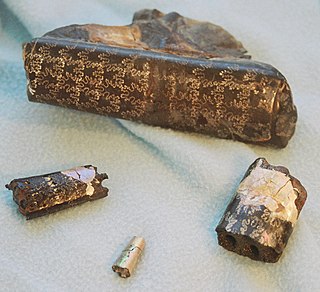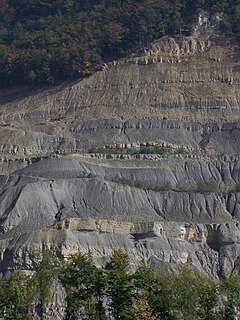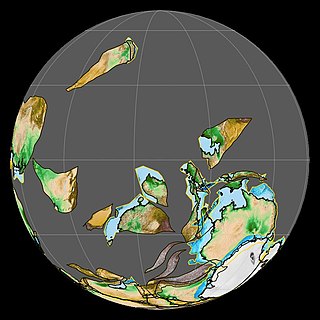Related Research Articles

The Barremian is an age in the geologic timescale between 129.4 ± 1.5 Ma and 121.4 ± 1.0 Ma). It is a subdivision of the Early Cretaceous Epoch. It is preceded by the Hauterivian and followed by the Aptian Stage.

Baculites is an extinct genus of cephalopods with a nearly straight shell, included in the heteromorph ammonites. The genus, which lived worldwide throughout most of the Late Cretaceous, and which briefly survived the K-Pg mass extinction event, was named by Lamarck in 1799.
The Toarcian is, in the ICS' geologic timescale, an age and stage in the Early or Lower Jurassic. It spans the time between 182.7 Ma and 174.1 Ma. It follows the Pliensbachian and is followed by the Aalenian.

The Aalenian is a subdivision of the Middle Jurassic Epoch/Series of the geologic timescale that extends from about 174.1 Ma to about 170.3 Ma. It was preceded by the Toarcian and succeeded by the Bajocian.

The Aptian is an age in the geologic timescale or a stage in the stratigraphic column. It is a subdivision of the Early or Lower Cretaceous Epoch or Series and encompasses the time from 121.4 ± 1.0 Ma to 113.0 ± 1.0 Ma, approximately. The Aptian succeeds the Barremian and precedes the Albian, all part of the Lower/Early Cretaceous.
In the geologic timescale the Bathonian is an age and stage of the Middle Jurassic. It lasted from approximately 168.3 Ma to around 166.1 Ma. The Bathonian Age succeeds the Bajocian Age and precedes the Callovian Age.
The Campanian is the fifth of six ages of the Late Cretaceous Epoch on the geologic timescale of the International Commission on Stratigraphy (ICS). In chronostratigraphy, it is the fifth of six stages in the Upper Cretaceous Series. Campanian spans the time from 83.6 to 72.1 million years ago. It is preceded by the Santonian and it is followed by the Maastrichtian.
The Danian is the oldest age or lowest stage of the Paleocene Epoch or Series, of the Paleogene Period or System, and of the Cenozoic Era or Erathem. The beginning of the Danian is at the Cretaceous–Paleogene extinction event 66 Ma. The age ended 61.6 Ma, being followed by the Selandian.
The Hettangian is the earliest age and lowest stage of the Jurassic Period of the geologic timescale. It spans the time between 201.3 ± 0.2 Ma and 199.3 ± 0.3 Ma. The Hettangian follows the Rhaetian and is followed by the Sinemurian.
The Pliensbachian is an age of the geologic timescale and stage in the stratigraphic column. It is part of the Early or Lower Jurassic Epoch or Series and spans the time between 190.8 ± 1.5 Ma and 182.7 ± 1.5 Ma. The Pliensbachian is preceded by the Sinemurian and followed by the Toarcian.

The Oxfordian is, in the ICS' geologic timescale, the earliest age of the Late Jurassic Epoch, or the lowest stage of the Upper Jurassic Series. It spans the time between 163.5 ± 1.0 Ma and 157.3 ± 1.0 Ma. The Oxfordian is preceded by the Callovian and is followed by the Kimmeridgian.
In the geologic timescale, the Kimmeridgian is an age in the Late Jurassic Epoch and a stage in the Upper Jurassic Series. It spans the time between 157.3 ± 1.0 Ma and 152.1 ± 0.9 Ma. The Kimmeridgian follows the Oxfordian and precedes the Tithonian.

The Tournaisian is in the ICS geologic timescale the lowest stage or oldest age of the Mississippian, the oldest subsystem of the Carboniferous. The Tournaisian age lasted from 358.9 Ma to 346.7 Ma. It is preceded by the Famennian and is followed by the Viséan.

Euhoplites is an extinct ammonoid cephalopod from the Lower Cretaceous, characterized by strongly ribbed, more or less evolute, compressed to inflated shells with flat or concave ribs, typically with a deep narrow groove running down the middle. In some, ribs seem to zigzag between umbilical tubercles and parallel ventrolateral clavi. In others the ribs are flexuous and curve forward from the umbilical shoulder and lap onto either side of the venter.
The Norian is a division of the Triassic Period. It has the rank of an age (geochronology) or stage (chronostratigraphy). The Norian lasted from ~227 to 208.5 million years ago. It was preceded by the Carnian and succeeded by the Rhaetian.

Stoycho Vassilev Breskovski was a Bulgarian paleontologist.
Garroniceras is genus of ammonite from the Upper Hauterivian, zones of Balearites balearis to Spathicrioceras seitzi.
Megacrioceratinae is an extinct ammonoid cephalopod subfamily. It has been described as family Megacrioceratidae in 2006, but later changed into subfamily under its current name. Ammonites belonging to this subfamily lived from Plesiospitidiscus ligatus zone of Upper Hauterivian until Avramidiscus kiliani zone of Lower Barremian.
Amorina is genus of ammonite from the Upper Hauterivian, zone of Pseudothurmannia angulicostata to lower Lower Barremian zone of Coronites darsi. It has probably evolved from Megacrioceratinae and gave rise to genus Mascarellina.

Leyvachelys is an extinct genus of turtles in the family Sandownidae from the Early Cretaceous of the present-day Altiplano Cundiboyacense, Eastern Ranges, Colombian Andes. The genus is known only from its type species, Leyvachelys cipadi, described in 2015 by Colombian paleontologist Edwin Cadena. Fossils of Leyvachelys have been found in the fossiliferous Paja Formation, close to Villa de Leyva, Boyacá, after which the genus is named. The holotype specimen is the oldest and most complete sandownid turtle found to date.